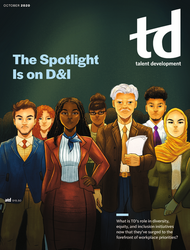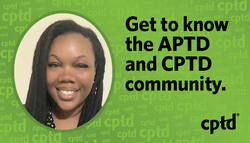TD Magazine Article
The Success and Failure of Soft Skills Programs
Ensure these 10 success factors are in place.
Thu Oct 01 2020

Bookmark
By reviewing and cataloging the barriers to and enablers of effective soft skills programs, talent development professionals can identify which factors determine success or failure. While success is always the ideal, much can be learned from failure. And in this case, failure does not necessarily mean the program did not deliver a positive return on investment or influence significant business impact measures; a program can fail if it did not live up to its expectations—at any level of outcome. It simply means that the program could have been more successful if adjustments or changes were made, and it will achieve success if those changes go into effect.
When properly designed and implemented, soft skills programs can deliver considerable ROI, sometimes reaching 100–500 percent. Consider the impact created when a leader changes their behavior after participating in a soft skills for leaders program. The change affects the entire team.
For example, the impact for a first-level team leader in a customer care center with 15 direct reports would be the improvement of the team. If productivity (in this case, call volume) improves because of the program, you can measure that improvement. When the monetary value from the team's improvement is compared with the cost of the formal training for one individual, the ROI value can be significant.
In our experience at ROI Institute, when this leverage or multiplicative effect is explained to chief financial officers, they get it. Consequently, we should expect high ROI from soft skills; if the expected returns are not there, we should determine what can be done to improve them.
The following presents the common reasons soft skills programs fail (or demonstrate a lack of success), leading to a specific success factor, which is presented in italics.
What results? (Lack of business alignment)
Based on ROI Institute's review of soft skills studies, the number 1 reason for lack of business results is that the program was not aligned to business needs in the very beginning. Most soft skills programs begin with behavior that should be developed and give little consideration for the business impact.
The assumption program designers make is that changes in behavior will positively affect the business. Unfortunately, that assumption is not always valid; executives want a clear path between an investment in behavior and the business impact. It is possible to connect leadership development to a business need at the beginning of the program. However, not every program should be evaluated at the business impact or ROI level. There must be a connection to the business if there is a desire and need to evaluate at that level.
Success factor 1: Align the program to business measures in the beginning.
Who wouldn't need this behavior? (Not assessing current behavior)
Too often, a new soft skills program is based on a new book, a popular model, or a successful program, and these behaviors may not be appropriate for your organization. Who could resist Seven Habits of Highly Effective People, Critical Conversations, the meditation in a mindfulness program, or a change management program? A clear understanding of the behaviors needed is critical.
Success factor 2: Identify specific behavior changes needed for the target audience.
Don't they know that already? (Not assessing learning needs properly)
The talent development field has a perpetual problem with learning solutions: They may not be needed. Just because a behavior is not in place does not necessarily mean that the target audience does not know how to use the effective behavior.
A learning solution may not be needed to force behavior change. Instead, it is sometimes a matter of expectations, role modeling, rewards, or any number of other solutions to drive the particular behavior. This issue can be pinpointed by asking proponents of the program if the target audience knows how to do this now. If the answer is yes, a learning solution is not needed.
Success factor 3: Identify learning needs for the target audience.
Who should be involved? (Not including the right participants)
A soft skills program is a popular topic, and several factors may cause individuals to want to be involved. For many of these programs, it can be argued that everyone needs to participate, which can cause confusion about need versus want and the target audience.
When the target participation group is vague and broad, all types of individuals may attend. The challenge is to ensure that the appropriate individuals are available at the right time and are motivated to learn and apply the content.
Success factor 4: Involve the right people at the right time.
Do participants know what they must accomplish? (Failure to create application and impact objectives)
The talent development profession generally has excellent capability for developing learning objectives. Learning objectives are written from a performance perspective, which suggests that participants should be able to perform in some way, often under certain conditions and even with a criterion representing quality, accuracy, or time. Regrettably, when it comes to soft skills programs, learning objectives are often left unclear.
Even worse, application and impact objectives are almost nonexistent. Application objectives define what participants are expected to do with what they learn, while impact objectives describe the consequences of application, expressed as a business measure.
Success factor 5: Establish application and impact objectives for soft skills programs.
Is the program designed properly? (Improper program design)
Sometimes the design of the program is the problem. Participants have different styles, and they learn in different ways. Their experiences, needs, and levels of performance vary. While the lack of proper content can be a design issue, problems often arise when the design is dysfunctional in terms of convenience, support, expectation, delivery, and facilitation.
The facilitator must gain participants' respect to inspire them to learn and apply. The program must meet schedule needs while addressing how people learn. Sometimes participants want to learn in pieces or modules. "Just for me," "just enough," and "just in time" are the requests.
Success factor 6: Design soft skills programs for successful learning and application.
What expectations? (Failure to secure commitment from participants)
Several issues are involved in setting expectations. Participants do not want surprises, so they must be made aware of the requirements and expectations for the program early and often. Also, they want to know what they must do to make the program successful. Program designers must provide the details, let participants know what they should do with what they learn, and define ultimate success. This means taking the mystery out of the process to avoid misunderstanding.
With proper business alignment, the mystery of application and impact can be removed, and participants are often reminded of those issues when application and impact objectives are developed. However, without these objectives, it is not unusual for participants to struggle with expectations. Without the business connection, the desired success probably won't occur.
Success factor 7: Create expectations to achieve results and provide data.
This won't work in my world! (Failure to remove or minimize barriers to application)
One of the most important causes of failure is barriers to the transfer of the learning to the job. While this has been a classic issue in talent development for decades, it becomes critical for soft skills, as there are many reasons why participants do not use the skills back on the job. Typical reasons for lack of application include that it does not fit in their world, they do not have time, it was not supported by their team, it was not applicable to what they do, or they prefer their current approaches. These barriers can bring any use of new skills to a halt.
The challenge is to address these barriers early—even during the initial needs assessment—to determine what would prevent newly learned behaviors from transferring to the job. Also, these barriers must be revisited often to address any problems as they are uncovered.
Success factor 8: Address the learning transfer issue early and often.
My manager didn't support this! (Failure to secure management support for the program)
With even the best designed programs, lack of management support will impede new knowledge from transferring to the place where it will be used. A participant's immediate manager is the number 1 enabler if they support it and the number 1 barrier if not.
New soft skills represent change, and applying any new skills or competencies often involves extra steps and effort. Behavior change requires a very supportive environment from the immediate manager, who must be involved and encourage, support, and sometimes even require the application of skills. To prevent a barrier from arising, the next level manager must be kept in the loop and ideally given an active role, not only in the expected changes but also in the expected results.
The most critical step for ensuring the application of soft skills to the job is to have the immediate manager set specific goals prior to the program participation. The second most critical item is ensuring follow-up from the immediate managers to determine if those results were achieved.
Success factor 9: Establish supportive partnerships with key managers.
They won't give me the data! (Not building data collection into the process)
Perhaps one of the greatest problems with evaluating soft skills is not being able to secure the appropriate amount and quality of data. Participants are perhaps the most credible individuals to provide the data, and the challenge often involves building data collection into the program and positioning it as an application tool.
With soft skills, an action planning process is one of the best methods to measure application and impact and collect the data necessary for an ROI evaluation. This process gives participants the opportunity to identify specific actions they will take to improve a selected business impact measure.
During the program, they can develop these plans, which are positioned as application tools for them to chart the success of using what they have learned. It provides a way to guide their application in an efficient manner and see the results achieved in terms of business impact and even monetary value. Data collection becomes an easy task when properly built into the process. Participation, completion, and return rates of the action plans are greatly enhanced when this occurs.
Success factor 10: Build data collection into the process and position it as an application tool.
Proper processes
The top 10 success factors for soft skills are presented in the order in which they normally occur in the learning program design process. Facilitators, developers, organizers, and supporters can use these factors to ensure the proper processes are in place for success. Most of the success factors need to be addressed, and three to six are usually missing from any given program design. This is often critical enough to inhibit the results.
This article is excerpted from chapters 1 and 2 of Proving the Value of Soft Skills: Measuring Impact and Calculating ROI (ATD Press).
Critical Soft Skills
An expert in the field, Bruce Tulgan, believes that there are 12 critical soft skills:
Self-evaluation. Assessing your own thoughts, words, and actions against clear meaningful standards. Also assessing your performance against specific goals, timelines, guidelines, and parameters.
Personal responsibility. Staying focused on what you can control directly—principally yourself—and controlling your responses in the face of factors outside your control.
Positive attitude. Maintaining and conveying a positive, generous, and enthusiastic demeanor in your expressions, gestures, words, and tone.
Good work habits. Maintaining wellness, self-presentation, timeliness, organization, productivity, quality, follow-through, and initiative.
People skills. Listening, observing, and reading; perceiving and empathizing; effective use of words, tone, expressions, and gestures (verbal, written, and otherwise); one-on-one and in groups; and in person and remotely.
Proactive learning. Keeping an open mind, suspending judgment, questioning assumptions, and seeking out information, techniques, and perspective. Also, studying, practicing, and contemplating information and skills to build your stored knowledge base, skill set, and wisdom.
Problem solving. Mastering established best practices as a way to avoid reinventing the wheel. Using repeatable solutions to improvise when addressing decisions that are new but similar.
Decision making. Identifying and considering multiple options, assessing the pros and cons of each and choosing the course of action closest to the desired outcome.
Respect for context. Reading and adapting to the existing structure, rules, customs, and leadership in an unfamiliar situation.
Citizenship. Accepting, embracing, and observing not just the rights and rewards but also the duties of membership, belonging, and participation in a defined group with its own structure, rules, customs, and leadership.
Service. Approaching relationships in terms of what you have to offer—respect, commitment, hard work, creativity, and sacrifice—rather than what you need or want.
Teamwork. Playing whatever role is needed to support the larger mission, including coordinating, cooperating, and collaborating with others in pursuit of a shared goal, and supporting and celebrating the success of others.

More from ATD

